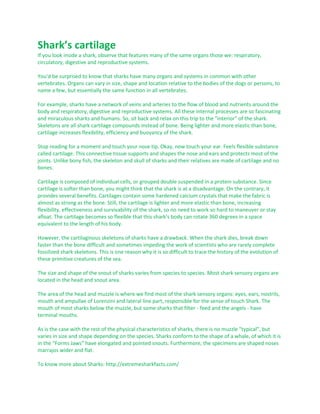
Shark and its characteristics
- 1. Shark’s cartilage If you look inside a shark, observe that features many of the same organs those we: respiratory, circulatory, digestive and reproductive systems. You'd be surprised to know that sharks have many organs and systems in common with other vertebrates. Organs can vary in size, shape and location relative to the bodies of the dogs or persons, to name a few, but essentially the same function in all vertebrates. For example, sharks have a network of veins and arteries to the flow of blood and nutrients around the body and respiratory, digestive and reproductive systems. All these internal processes are so fascinating and miraculous sharks and humans. So, sit back and relax on this trip to the "interior" of the shark. Skeletons are all shark cartilage compounds instead of bone. Being lighter and more elastic than bone, cartilage increases flexibility, efficiency and buoyancy of the shark. Stop reading for a moment and touch your nose tip. Okay, now touch your ear. Feels flexible substance called cartilage. This connective tissue supports and shapes the nose and ears and protects most of the joints. Unlike bony fish, the skeleton and skull of sharks and their relatives are made of cartilage and no bones. Cartilage is composed of individual cells, or grouped double suspended in a protein substance. Since cartilage is softer than bone, you might think that the shark is at a disadvantage. On the contrary, it provides several benefits. Cartilages contain some hardened calcium crystals that make the fabric is almost as strong as the bone. Still, the cartilage is lighter and more elastic than bone, increasing flexibility, effectiveness and survivability of the shark, so no need to work so hard to maneuver or stay afloat. The cartilage becomes so flexible that this shark's body can rotate 360 degrees in a space equivalent to the length of his body. However, the cartilaginous skeletons of sharks have a drawback. When the shark dies, break down faster than the bone difficult and sometimes impeding the work of scientists who are rarely complete fossilized shark skeletons. This is one reason why it is so difficult to trace the history of the evolution of these primitive creatures of the sea. The size and shape of the snout of sharks varies from species to species. Most shark sensory organs are located in the head and snout area. The area of the head and muzzle is where we find most of the shark sensory organs: eyes, ears, nostrils, mouth and ampullae of Lorenzini and lateral line part, responsible for the sense of touch Shark. The mouth of most sharks below the muzzle, but some sharks that filter - feed and the angels - have terminal mouths. As is the case with the rest of the physical characteristics of sharks, there is no muzzle "typical”, but varies in size and shape depending on the species. Sharks conform to the shape of a whale, of which it is in the “Forms Jaws" have elongated and pointed snouts. Furthermore, the specimens are shaped noses marrajos wider and flat. To know more about Sharks: http://extremesharkfacts.com/